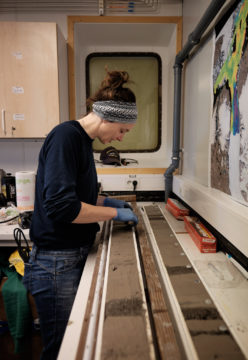Marine geophysical studies in the Arctic
- Start date
- 1 July, 2015
- End date
- 1 July, 2015
This research focuses on investigating the glacial histories of Arctic ice sheets and ice caps using the marine geological record preserved on continental margins. By reconstructing past ice sheets, their glacial dynamics, and their deglacial chronologies (i.e., rates of retreat) we can place recent glacier change in the Arctic in longer-term context of climatic variability and we can identify key controls on ice retreat. In addition, the decay of Arctic ice sheets can provide useful analogues, in terms of the timing and nature of retreat, for the behaviour of the modern Antarctic ice sheet. For example, the marine-based Barents Sea Ice Sheet that covered the entire Barents Sea during the last glacial is comparable to the present Western Antarctic Ice Sheet (WAIS), which is also grounded below sea level. We use primarily marine geophysical and geological datasets to map and date seafloor glacial landforms produced during the Last Glacial Maximum (LGM, about 20,000 years ago) and the following deglaciation.
Current research topics include:
Ice-sheet reconstruction and deglacial history of the northern Barents Sea Ice Sheet, east of Svalbard
Deglaciation of the central West Greenland continental margin since the LGM
Past glacier dynamics and glacimarine sedimentary processes in Petermann Fjord, NW Greenland

Kelly Hogan
Marine Geophysicist
BAS-Arctic Working Group, Palaeo Environments, Ice Sheets and Climate Change team
External collaborators
Professor Julian Dowdeswell, Scott Polar Research Institute, University of Cambridge
Professor Colm Ó Cofaigh, Durham University
Dr Anne Jennings, INSTAAR, University of Colorado
Professor Martin Jakobsson, Stockholm University
Dr Riko Noormets, University Centre on Svalbard (UNIS)
